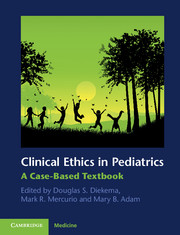Book contents
- Frontmatter
- Contents
- Contributors
- Preface
- Section 1 Core issues in clinical pediatric ethics
- Section 2 Ethical issues at the beginning of life: perinatology and neonatology
- Section 3 When a child dies: ethical issues at the end of life
- 18 End-of-life care: resolving disputes over life-sustaining interventions
- 19 Futility
- 20 Advance directives and DNR orders
- 21 The determination of death
- 22 Physician-assisted dying in children
- 23 The Groningen Protocol
- 24 Defining beneficence in the face of death: symptom management in dying children
- Section 4 Ethical issues posed by advances in medical technology and science
- Section 5 Children, public health, and justice
- Section 6 Special topics in pediatric ethics
- Index
- References
20 - Advance directives and DNR orders
from Section 3 - When a child dies: ethical issues at the end of life
Published online by Cambridge University Press: 07 October 2011
- Frontmatter
- Contents
- Contributors
- Preface
- Section 1 Core issues in clinical pediatric ethics
- Section 2 Ethical issues at the beginning of life: perinatology and neonatology
- Section 3 When a child dies: ethical issues at the end of life
- 18 End-of-life care: resolving disputes over life-sustaining interventions
- 19 Futility
- 20 Advance directives and DNR orders
- 21 The determination of death
- 22 Physician-assisted dying in children
- 23 The Groningen Protocol
- 24 Defining beneficence in the face of death: symptom management in dying children
- Section 4 Ethical issues posed by advances in medical technology and science
- Section 5 Children, public health, and justice
- Section 6 Special topics in pediatric ethics
- Index
- References
Summary
Case narrative
A 16-year-old female with advanced cystic fibrosis is admitted to the pediatric intensive care unit in severe respiratory distress. She is being supported by non-invasive ventilation, but her respiratory failure is progressing and she will likely need to be intubated in the next several hours. She has adamantly refused her pulmonologist’s request that she be listed for lung transplant, stating “I have thought about this for years, I have talked with other CF patients who did and did not get a lung transplant, and I would rather die than go through that.” Her parents want her to be listed for lung transplant. A short time later, while in severe respiratory distress, the patient asks to speak to her attending physician without her parents present. In this conversation she tells her physician, “I know I will not be able to communicate much longer, but no matter what happens do not let my parents list me for a lung transplant. I would rather die than go through all that transplant stuff.” Should the patient’s physician honor the adolescent’s wishes or those of her parents?
Introduction
In August 1976 the New England Journal of Medicine published the first descriptions of do-not-resuscitate (DNR) policies. The issue contained two separate articles from two Harvard teaching hospitals describing their policies on the framework for decision-making about the resuscitation status of patients at their hospital (Clinical Care Committee, 1976; Rabkin et al., 1976). A third article on the subject in that issue was a commentary by a Harvard law professor, and later Solicitor General of the United States, arguing that orders not to resuscitate were likely consistent and legal under the United States constitution (Fried, 1976).
- Type
- Chapter
- Information
- Clinical Ethics in PediatricsA Case-Based Textbook, pp. 112 - 117Publisher: Cambridge University PressPrint publication year: 2011
References
- 1
- Cited by



